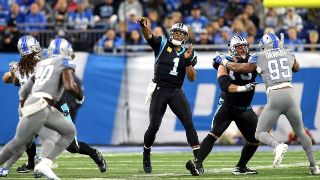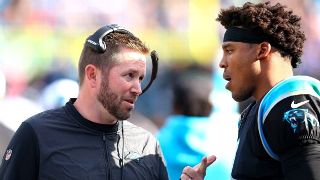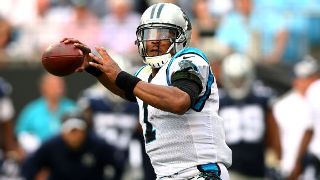|
CHARLOTTE, N.C. -- Much was made last week of Carolina Panthers quarterback Cam Newton throwing for the first time since having shoulder surgery in January. It’s only natural, as the team's hopes for success are tied to Newton’s right arm. But it’s what the 2015 NFL MVP has done with his feet and upper body since rehab from his surgery that will have the biggest impact on his future. It’s an extension of a process that began last year to tweak Newton’s mechanics to put less stress on the shoulder and improve his accuracy. “We’re just keeping him compact, making sure his feet and his eyes are working together,” Panthers quarterbacks coach Scott Turner said. “That’s where we really started. It’s carried over into this offseason, making him a little more compact in his upper body, a little more closed off, just to make him as efficient as possible and putting the least amount of stress possible. “Now you’re going to put stress on your arm throwing the ball. It’s not a natural movement. But [we’re putting] as little as we can, on his shoulder, to take care of him.”  Back on the back footNewton came into the NFL as the top pick of the 2011 draft with a tendency to throw off his back foot, relying on pure arm strength. In part because of his threat as a runner, he often would find himself throwing with his legs parallel to the line of scrimmage. That put more stress on his shoulder. When the feet and body are aligned with the target, that stress is reduced. “Not to get too technical, but you strike the ground with your back foot and generate power and then it moves through your hips into your upper body,” Turner said. “And with your feet, if you put your weight on your back foot, the weight is not transferring.” It’s no different than a pitcher in baseball getting his extension leg and glove elbow aligned, or a golfer lined up properly for a swing. “You generate power with your body, so you want your lower body moving in the direction you’re throwing,” Turner said. “And if it moves in the opposite direction, you put more stress on the upper body and you have to correct it with your arm. “Just having everything working in unison, that’s where it starts.” Newton made great strides in changing his motion last season. It set him on a path for a career-high 67.9 completion percentage. He completed 58.5 percent of his passes in his first seven seasons. But when the shoulder became sore after a 6-2 start, when the training staff began restricting his throwing during the week, Newton reverted to his old mechanics. Former NFL quarterback Tim Hasselbeck, now an analyst for ESPN, agrees a more compact motion with the focus on footwork should help ease stress on Newton’s shoulder. “Cam to me has kind of throughout his career has taken a big, long stride, which raises his left shoulder, which lowers his left elbow,” Hasselbeck said. “When live bullets have been flying, he’s reverted back to that type of technique when throwing in actual games. “He gets squared too often ... which is the worst possible place you can be as a passer. So now you’re all upper body at that point.”  Upper-body tweaksQuarterbacks work to perfect their footwork all the time. Tinkering with the upper body is less common, several former NFL quarterbacks said. “Just because, one, it takes a lot of work to change,” Hasselbeck said. “Think about how many times you’ve thrown a football. It might be hundreds of thousands. So you get in that muscle memory where there are certain routes you could throw with your eyes closed.” Hasselbeck said because Newton hasn’t always been a “great anticipator” when it comes to recognizing pressure in the pocket, his body is more out of line and the throws have “been pretty violent.” “It’s, ‘OK, now I see [the pressure], big stride, throw real hard,’" Hasselbeck said. “I don’t know where his shoulder problems originated. I would be surprised if it was from too much throwing. “So Cam -- and this a lot of times is the case with guys who are really good runners -- their feet get all out of sorts because they might be on their way to running. So rather than kind of the Tom Brady type of footwork in the pocket, ‘OK, I’m hanging in here, I’m hanging in here,’ it’s like, ‘OK, my feet are now parallel to the line of scrimmage. Oh, shoot, now I have to throw the football.’" Newton, 30, has been hit a lot since entering the league in 2011. He has gotten better at sliding and running out of bounds as opposed to taking tacklers head-on, but he still had more than 100 carries last season. “How much do you bruise the shoulder joint in running and hits of that nature?” said former Carolina quarterback Jake Delhomme. “If he can do a good job of protecting himself, which is hard to do because that makes him different than any quarterback I’ve ever seen, that’ll help. He’s going to have to be smart.”  Muscle memoryHasselbeck believes one reason Newton reverted to his old style when the arm became sore last season was because he didn’t throw in practice for much of the final eight to 10 games. The muscle memory he worked hard to perfect during the offseason and training camp was forgotten. “It’s a tedious process,” Hasselbeck said. “I don’t think it’s something you can take a vacation on. ... You continue to do it so long that you forget you used to do it the other way. “It’s got to be a massive commitment. It’s got to be something you always work on all the time.” Delhomme, who is going to be a radio analyst for the Panthers this season, agreed. “Taking a quarterback off the field and not working on rhythm and timing, I don’t care how great you are, that is very difficult on a Sunday afternoon to be at your best,” he said. “It’s going to be the health deal and hits on that shoulder.” From what Turner has seen in Newton’s rehab, he believes the quarterback is “fully committed” to the tweaks in his mechanics and protecting himself in games. “He’s still throwing the ball just as far as his setup, the way he starts and being more closed off, it’s not that much different,” Turner said. “And the work until the season is what’s going to build that muscle memory.” It’s still not an easy process, especially at Newton’s age. “It’s hard to change something you’ve been doing for most of your life,” Hasselbeck said. “Think about when you’re used to your iPhone a certain way. Then you hit update and now you’re like, ‘Wait a minute? Where was my camera?’ It throws you off.” But for Newton’s long-term health and success, the change appears necessary. “When your feet match your eyes, you’re going to make decisions faster,” Turner said. “Also, getting his feet consistent helped the ball go where he wanted it to go. And then getting the ball out of your hand is going to help your completion percentage. “It all works together. The upper body, lower body when you’re playing quarterback, it all works in unison.”
|
